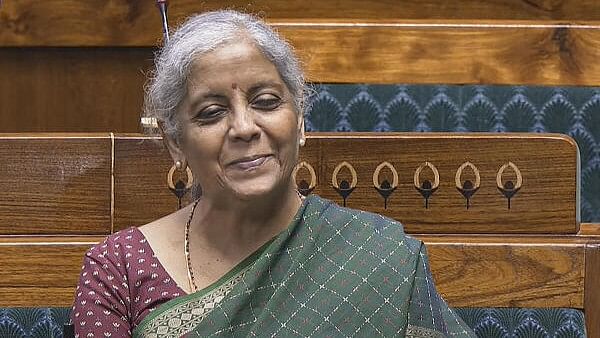
Finance Minister Nirmala Sitharaman
Credit: PTI Photo
It is an oft-quoted axiom that the Indian Budget is as much a political as an economic document. This probably rings truer than ever before for the Modi 3.0’s first foray into balancing finances. Lessons have been learnt from the electoral setbacks faced by the ruling party.
The focus on employment and skilling shows there is a recognition that this is the biggest worry for most people. The push to provide funding to Bihar and Andhra Pradesh is driven by the compulsions of coalition politics. The Janata Dal (United) and the Telugu Desam Party are critical to this government’s survival and their respective states have been accorded the highest priority in preparing this financial document.
The political nature of the Budget can be viewed as a criticism, but is its greatest strength. The decision to take direct measures to resolve the widespread issue of joblessness will probably yield better results than the earlier reliance on the trickle-down approach from infrastructure investments. The employment proposals include a provision for subsidising the first month’s salary to new hires in the formal sector. This has also been extended to allocations for the provident fund which will continue for four years. The two schemes are linked to persons entering the workforce for the first time and are likely to be viewed warily by industry.
The third scheme, envisaging subsidy for provident fund contribution over a two-year period for any additional employment seems slightly more attractive. This is not confined to new entrants so it can provide a benefit of bringing eligible personnel. Whether this will be enough of a lure to hire more people will be seen only in the coming months.
The second element of the employment incentives is a one-year internship programme at top corporates for a million young people. Some costs on this score will have to be borne by employers from their corporate social responsibility funds.
The snag in these schemes is the response of trade and industry. Will companies be prepared to take on additional employees who may be considered surplus? The wage subsidy is merely for one month and does not eliminate the long-term salary burden. Taking care of the employers’ share of the provident fund is a marginal incentive for creating more jobs.
On the other hand, the internship programme could be successful as it eliminates any compulsion to provide a job. It should also make the intern more employable. This is with the caveat that the corporate sector provides adequate training.
Much is going to depend on the nuts and bolts of these schemes. Finance ministry officials concede the proposals are just a nudge to industry. Yet such amounts could make a difference at the margins between opting for fresh employment or relying on AI.
The other Budget highlight is the stress on eastern region development with specific allocations mentioned for projects in Bihar and Andhra Pradesh. Here the motivation to outline investments for specific projects stems from the compulsions of coalition politics. It is well known that both Nitish Kumar and Chandrababu Naidu have sought special category status for their states. In place of meeting that demand, financing has been pledged for a slew of projects. These include road and power infrastructure in Bihar and for the new capital Amaravati and the long pending Polavaram irrigation project in Andhra Pradesh.
The fact is that the focus on Bihar should be welcome if it helps push this large state out of poverty and backwardness. Though its growth rate in recent years has been much faster than the national average, it remains the country’s poorest state in terms of per capita income. Recent reports of a spate of bridge collapses indicate that corruption in infrastructure projects is also widespread. Against this backdrop, more help is certainly needed to bring about sustainable development in the state.
Andhra Pradesh, in contrast, is one of the country’s most prosperous states ranking sixth in terms of per capita income. At the same time, it requires a huge infusion of funds for the new capital being set up at Amaravati. The Budget proposals make it clear, however, that much of the funding will be arranged through multilateral financing agencies.
The political nature of this year’s Budget is thus undeniable as it pervades much of the key provisions. At the same time, Finance Minister Nirmala Sitharaman cannot be accused of profligacy while seeking to fulfil the demands imposed by a weaker coalition government. The fiscal deficit has been brought down to 4.9 per cent from 5.1 per cent in the Interim Budget. This has been done without giving any major tax concessions barring the hike in standard deduction for salaried employees. As for the new job creation proposals, they are a small step in the right direction though success will depend on the response of trade and industry.
(Sushma Ramachandran is a senior journalist.)
Disclaimer: The views expressed above are the author's own. They do not necessarily reflect the views of DH.
Union Budget 2024 LIVE | Making a record for any Finance Minister, Nirmala Sitharaman presented her 7th consecutive Union Budget on July 23, 2024 under the Modi 3.0 government. This Budget brought tax relief for the middle class, while focusing on jobs through skilling, incentivising employers. Track the latest coverage, live news, in-depth opinions, and analysis only on Deccan Herald. Also follow us on WhatsApp, LinkedIn, X, Facebook, YouTube, and Instagram.